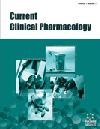- Home
- A-Z Publications
- Current Clinical Pharmacology
- Previous Issues
- Volume 8, Issue 1, 2013
Current Clinical Pharmacology - Volume 8, Issue 1, 2013
Volume 8, Issue 1, 2013
-
-
Plasma Pharmacokinetics of Antimicrobial Agents in Critically Ill Patients
More LessBy Federico PeaPrompt optimal antimicrobial treatment in critically ill patients is mandatory and must be achieved not only in terms of spectrum of activity, but also in terms of exposure at the infection site. Plasma profile of antimicrobial agents may represent a valid surrogate marker of drug exposure and allow to identify the correct dosage for a given drug. However, in the critically ill patients the pharmacokinetic behavior of antimicrobials Read More
-
-
-
Continuous Infusion of Antibiotics in Critically Ill Patients
More LessAuthors: Piotr Smuszkiewicz, Edyta SzaÅ,ek, Hanna Tomczak and Edmund GrzeskowiakAntibiotics are the most commonly used drugs in intensive care unit patients and their supply should be based on pharmacokinetic/pharmacodynamic rules. The changes that occur in septic patients who are critically ill may be responsible for subtherapeutic antibiotic concentrations leading to poorer clinical outcomes. Evolving in time the disturbed pathophysiology in severe sepsis (high cardi Read More
-
-
-
Antimicrobial Drug Interactions in the Critically Ill Patients
More LessAuthors: Jose M. Pereira and Jose A. PaivaCritically ill patients are typically polymedicated and therefore at a high risk for potential drug interactions. Clinical consequences of drugs interactions vary in severity from mild to lethal events. Since infection is an important issue in the Intensive Care Unit (ICU), a significant number of patients will receive an antimicrobial at some stage during their ICU admission. Therefore an adequate knowledge about possible intera Read More
-
-
-
Effects of Renal Replacement Therapy on Antimicrobial Therapy
More LessAuthors: Matthias G. Vossen and Florian ThalhammerAntimicrobial therapy in patients receiving renal replacement therapy (RRT) is challenging due to the varying pharmacokinetic profile of each drug - membrane - technique combination. Renally excreted drugs are usually affected by RRT to a much higher extend than hepatically excreted drugs. However, highly protein bound drugs might be eliminated during RRTs regardless of their usual route of elimination through the formatio Read More
-
-
-
Methods to Measure Target Site Penetration of Antibiotics in Critically Ill Patients
More LessAuthors: Richard Schwameis and Markus ZeitlingerWhile several tools are necessary to repair a car, the engineer knows exactly which instrument he has to utilize at different parts of the broken machine. Likewise, depending on the information we are interested in, we have to choose different tools to investigate and consecutively understand the multiple aspects that are involved in pharmacokinetics of antimicrobial agents in critically ill patients. Some techniques, l Read More
-
-
-
Use of Antiplatelet Therapy after Percutaneous Coronary Intervention with Bare-Metal Stents and Different Types of Drug-Eluting Stents
More LessAuthors: Tarunjit Singh, Linda Cuomo, Martin Cohen, Hasan A. Ahmad and Wilbert S. AronowDual antiplatelet therapy (DAPT) with a thienopyridine and aspirin has been the standard of care post coronary stent implantation. DAPT has been shown to reduce the risk of stent thrombosis (ST) and complications of myocardial infarction and death after placement of a drug-eluting stent (DES) and bare-metal stent (BMS).This article reviews the available clinical efficacy and safety data of antiplatelet therapies. The aim of Read More
-
-
-
The Intestinal Absorption Mechanism of Gabapentin Makes it Appropriate for Gastroretentive Delivery
More LessAuthors: Cuiping Chen, Verne E. Cowles and Michael SweeneyGabapentin is approved for the treatment of postherpetic neuralgia (PHN) and epilepsy. The pharmacokinetic (PK) properties of gabapentin, including absorption, distribution, metabolism, and excretion (ADME), were investigated during the development of Neurontin®, an immediate-release (IR) formulation of gabapentin that is orally administered three-times daily. Recently, a gastroretentive (GR) once-daily formulati Read More
-
-
-
Neglected Aspects of Drug Discovery - Microbiological Aspects
More LessAuthors: Jacob Golenser and Nicholas HuntDeveloping new, efficient drugs is a long and costly process. However, although a failure to establish new drugs can in part be related to lack of funding, often it is also associated with various deficiencies in current approaches to drug development. Chemical and genetic validation, in addition to estimating future drug resistance, are considered critical for predicting the therapeutic efficacy of a compound. However, such appro Read More
-
-
-
Phase I Clinical Trial of Exherin (ADH-1) in Patients with Advanced Solid Tumors
More LessAuthors: Nirit Yarom, David Stewart, Rajesh Malik, Julie Wells, Leonard Avruch and Derek J. JonkerADH-1 (Exherin™) is a pentapeptide, which competitively inhibits N-cadherin, resulting in vascular disruptive effect of tumor vasculature in preclinical models. This study was designed to assess the toxicity of ADH-1 and to determine the maximal tolerated dose (MTD). Patients and Methods: Adult patients with advanced measurable solid tumors were stratified according to their tumor N-cadherin status. ADH-1 was a Read More
-
Volumes & issues
Most Read This Month
Article
content/journals/ccp
Journal
10
5
false
en


